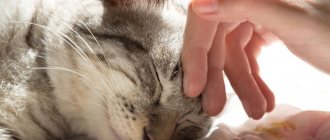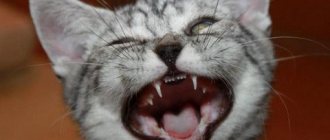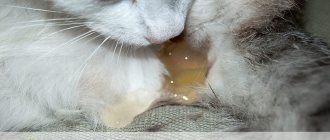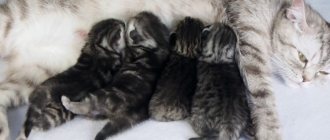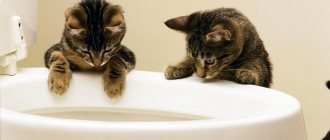Biologists have come to the conclusion that the heat exchange function of cats is very similar to humans, so they also suffer from heat, they have problems with the cardiovascular system, and animals can get heatstroke.
Monitor your pet's condition and come to his aid in time
It is important for owners to monitor the condition of their pet, come to its aid in a timely manner and competently apply simple procedures to save their pet from the heat. But not all owners know what to do if the cat is hot. After all, most of us are accustomed to thinking that cats are self-sufficient and independent animals that cope well with their problems alone.
To some extent, this point of view is justified, and cats really try to help themselves, but only until the moment their body’s resources allow it. And in very intense heat, pets will not refuse human help and will be grateful for their timely intervention in a critical situation.
If your cat is hot, wrap him in a damp towel
When the situation gets critical
The cat lay down to rest in the shade and fell asleep, and the sun moved, and the animal found itself under its direct rays. Such cases are not isolated, and it is good if the animal woke up in time and moved into the shadows. And if not? Then it may get sunstroke or heatstroke.
The owner's actions in this case: move the animal to a cool, shaded place and place a napkin moistened with cool water on its head. Keep an eye on your pets who like to take a nap in the sun; after receiving a blow, they may have enough strength to move into the shade on their own, but they certainly won’t have enough strength for normal active movements: even trying to drink water will become a problem for the animal.
If you notice that the animal has become lethargic and apathetic, wrap it in a damp towel and immediately go to the vet - heat stroke can cause the death of the cat.
A cat can find relief from the heat in the bathroom
Unfortunately, many cat owners treat their pets quite irresponsibly, leaving them in a stuffy room all day without access to cool areas and water. The problem of what to do if the cat is hot can be solved by leaving the doors to the bathroom open - for the animal, the opportunity to simply lie down on the cool tiled floor can be a salvation.
Cats living in apartments in high-rise buildings that are not equipped with air conditioning suffer more than others from the heat - in summer, in housing located on the upper floors, it is especially stuffy, and the animal, closed until the owners arrive, is deprived of the opportunity to receive a flow of fresh air. These cats are more likely to experience heatstroke.
Another mistake that pet owners make is to transport their pets in a car without air conditioning in the midst of the sun, and even leave them locked in the car for several hours.
Many owners consider haircuts to be the easiest way to save a cat.
Features of sweating in sphinxes
The process of sweating primarily depends on the length of the cat's coat, although both long-haired and short-haired pets sweat equally. But among the representatives of the cat family there are breeds that are characterized by excessive sweating. These include all hairless cats - Sphynxes.
Interesting! According to the results of research by felinologists, sweating occurs most actively in Canadian sphinxes, and slightly less intensely in Don sphinxes.
Hairless cats have sweat glands everywhere, so the Sphynx sweats all over her body. However, the intensity of sweating in these cats depends in most cases on health, nutrition, age and even emotional state. In addition, sphinxes do not lick themselves like their furry relatives.
The real problem for owners is the sweat of representatives of the breed, because it remains in the form of brown spots not only on the cat’s skin, but also on all surfaces where it lay.
The only solution for owners in this situation is special skin care for the Sphynx. A cat of this breed will have to be bathed quite often or at least wiped with a damp cloth. In addition, due to the lack of fur, sphinxes are very susceptible to hypothermia. That is why your hairless pet definitely needs to arrange a warm place to rest and purchase several sets of clothes.
"Fur coat" and summer
On hot days, cats are greatly inconvenienced by their pride – their thick fur. In summer, cats get rid of it somewhat by molting, but at high air temperatures this does not help the animals much, and they continue to succumb to the heat. The fur coat is especially annoying for long-haired cats and cats with dense hair.
Many owners consider haircuts to be the easiest way to save a cat. Well, what should you do if your cat is hot in the summer? Just cut your hair! If you give a cat a haircut in a salon, it will be both aesthetically pleasing and will solve the problem of the animal overheating. If at home, then the problem will definitely be solved, but the beauty of the cat may suffer.
Not all owners decide to deprive an animal of its external attractiveness with a custom haircut, so the question of what to do if the cat is hot remains relevant for many. Of course, there are ways to save uncut cats from overheating. One of them is water, but the liquid needed in the heat must be used very wisely so as not to aggravate the problem.
To effectively cool the animal, it must be immersed in water.
Important! Under no circumstances should you wet your cat's fur with water only from above - this will create a greenhouse effect, and it will make your pet even worse.
To effectively cool the animal, it is necessary to immerse it in water (except for the head), or pour it from the shower so that the liquid penetrates directly to the skin.
What to do if the cat is hot, but she is afraid of water and will not crawl under the stream under any circumstances? This is also a relevant and burning question, to which there is a simple answer: it is necessary to cool the animal’s blood by placing containers of cold water in the area where the most important arteries are located - armpits, stomach, thighs.
At-risk groups
Just like people, there are risk groups among cats. Overheating threatens every cat without exception, the only question is the critical temperature . It is worth considering that animals individually tolerate air humidity in hot weather; some cats do better in dry air, while others do better in humid air. Animals at risk for heatstroke include those suffering from:
- Chronic diseases of the heart, vascular system, respiratory tract, hormonal system.
- Obesity, which is considered not a disadvantage or a temporary problem, but a disease.
- Natural degenerative changes (elderly animals over 7–8 years old).
A special risk group includes cats with shortened and depressed faces. Such breeds have breathing problems, and in the heat, only steamy air circulation through the respiratory tract saves the cat from overheating. Hairless cats (Sphynxes, Levkoi) are also prone to overheating, since fur not only warms or decorates, but also performs the function of thermoregulation.
Some cats have an undercoat, but regardless of its presence, there is a so-called air chamber under the cat's fur. The air in this chamber maintains a constant temperature of 38–39° , which helps the cat warm up in the cold and maintain normal body temperature in the heat. Many owners cut their cats' hair to help them cope with the heat, but in fact, short haircuts cause even more problems . A long-haired cat can be trimmed with scissors, but cutting off the fur completely is not recommended.
Note! The only case in which a clipper haircut is relevant is when there are a large number of tangles.
Owners of pets at risk need to prepare for the heat responsibly. Visit your veterinarian for advice on the best treatment options. Animals suffering from heart failure are prescribed maintenance therapy during the summer. Ask your doctor what medications you need to have on hand if your pet becomes ill and how to provide the most competent first aid.
Important! We recommend not to listen to the advice of friends, even if they have experienced heatstroke in a pet. All animals are individual, and assistance and the use of medications according to a standard regimen are not always relevant. In case of heatstroke, if the animal has chronic pathologies, supportive therapy and cooling are much more important than other measures.
Cat diet in hot weather
With the onset of a hot period, most cats' appetite sharply decreases; they do not finish their usual portions, or even refuse food altogether, preferring to drink heavily.
But the animal cannot avoid eating at all in the heat, so owners need to reconsider their pet’s diet, replacing fatty foods with lighter ones.
Advice! The best option for feeding a cat in summer is fish and dry food.
However, experts say that cat food pellets contain too much salt, and cats feel very thirsty after eating them, so it is better to give wet food to animals in small portions.
The owners determine the time of feeding the pet themselves, but in hot weather it should not be the lunch or afternoon period - it is better to choose the morning or evening hours, when the air temperature is not very high.
In summer, you should feed your cat dry food.
The cat is alone in the apartment
If the owners are forced to leave their pet alone for the whole day in a stuffy apartment, they are obliged to provide the cat with comfortable conditions in which the animal can more easily tolerate the heat:
- give the animal access to the bathroom;
- provide the cat with a sufficient amount of drinking water (put out not one bowl, but several);
- ventilate the apartment;
- leave a damp towel on the cat bed;
- hang wet sheets and towels in the apartment.
But if the room is too stuffy, the method of humidifying the air with wet towels will not work, since humid and hot air can negatively affect the functioning of the animal’s cardiovascular system.
Attention! The cat himself is able to find the most comfortable and coolest place in the apartment.
If he finds one and is escaping the heat there, do not drive the animal away, even if its presence causes you inconvenience.
When leaving your cat alone, provide him with enough drinking water.
How to tell if a cat is hot
Cats always find a way to inform their owners about their condition and their problems. In the heat, not a single cat will sleep on the sofa or in an armchair - they all move together to the floor, and if it’s not cool enough there, they change their position: they don’t curl up, but turn over on their backs and stretch out to their full height to let out excess warmth.
Most of the heat receptors in cats are located on their stomachs; by turning over on their backs, animals try to cool themselves down on their own.
A cat sleeps on its back - this is the first signal to the owners that the animal is hot, as well as lack of activity and appetite, plaintive meowing, attempts to sleep in the bathtub or sink.
What should you do if your cat is very hot and has already tried all independent ways to cool down? You can periodically wet the animal’s paw pads with cool water, try to maintain the temperature in the apartment no higher than 24 °C, it’s good if the house has air conditioning, then the problem can be considered solved.
A cat sleeping on its back is the first signal to its owners that the animal is hot
If a cat has a heatstroke, the animal becomes sad and lethargic, stomach upset, redness of the mucous membranes of the eyes, and even fainting are possible. If such symptoms occur, the animal must urgently measure its body temperature (with a standard thermometer, carefully inserting it into the cat’s rectum), and if it is higher than normal (the norm in cats is –37.5-38.5 °C), it is necessary to urgently deliver the pet to the veterinary hospital.
Wetting
If the cat is hot and you can see it with the naked eye, pick him up, take him to the bathroom and wet his paw pads with cool (not cold!) water from the tap. You can also touch the ears with damp, cool hands. Be careful not to let water get into your ear. To do this, shake off your hands first so that no drops remain on them.
These measures will help cool the cat, although he most likely will not like the procedure, because... cats don't like to get their paws wet. But there are also those who take the initiative themselves and go swimming. Some people put their heads under the tap, while others bathe entirely in a basin or bathtub. Is your cat like this? Then make sure that a basin of water or a bathtub 20 centimeters deep is always full. There is no need to go deeper, because if the cat does not know how to swim, he may drown.
